What is the difference between a straight and angled nailer?
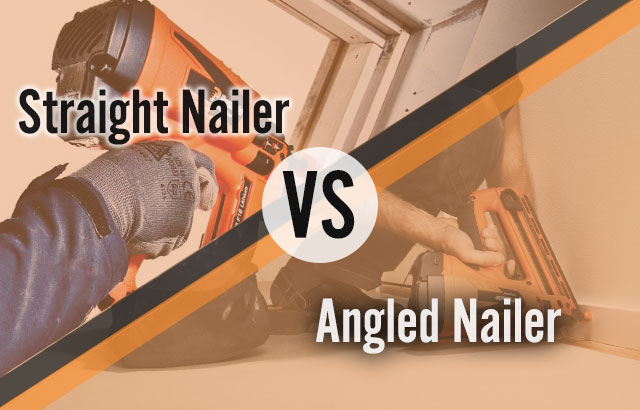
If we are going to answer this question fairly, it is important to choose two tools which work in similar applications. With that in mind, we have selected two 16 guage cordless gas second fix nail guns from Paslode.
In this piece, we establish:
- What is a nail gun?
- What is a cordless gas nailer and how does it work?
- What are the advantages and disadvantages of each tool?
What is a nail gun?
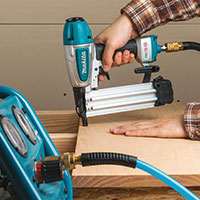
The purpose of any powered nailer or ‘nail gun’ is to fire in nails at the pull of a trigger. Unlike a traditional hammer, nailers can drive the fastener into the material instantly, eliminating the repetitive strikes required when using a hand tool. Not only does this remove the physical aspect of hammering a nail, but it also eliminates the jarring and vibration being fed back to the operator. Of course, in any working environment, time is money, and a nail gun is incomparably faster than a good old-fashioned hammer.
Another consideration is the space a nailer can work in; a hammer needs to be swung which requires a lot of working space. A nail gun on the other hand, generates all its nail driving power within the tool itself – so if the tool can fit in the gap, the nail can go in.
Until Paslode came along with their impulse gas technology, all nailers were pneumatic machines, powered by compressed air. A pneumatic tool is connected to an air compressor by way of an air hose. In large workshops there may be a large central compressor and an integrated airline system, which operators connect into. This has proven to be a very reliable system and is popular in many production environments.
The main downside though, is portability. Pneumatic tools cannot work without an air supply and even the smallest portable air compressors are quite heavy. The other issue is the hose itself, which can damage work surfaces and be a trip hazard.
In 1986, Paslode invented the world’s first cordless gas nailer…
What is a cordless gas nailer & how does it work?
Paslode developed the first ever cordless gas nailer, combining a battery and fuel cell. This innovative design offers true portability and eliminates the need for compressors and air lines.
So, without compressed air, how do they work? A spark, created by the battery, ignites a measured dose of gas from the fuel cell causing a tiny explosion. It is the subsequent expanding gas from this ignition that pushes a piston, which in turn, drives the nail.
Effectively, what Paslode had succeeded in doing, was to place a small internal combustion engine – just like the one in your car, inside a power tool casing. Currently, the combustion engine is the most widely used power-generating device in existence and it has certainly proved its reliability throughout the range of Paslode impulse gas tools.
As an approved service agent for Paslode tools, our Service Centre manager has this to say:
“There is a very simple cleaning procedure to perform on Paslode tools, which only takes 15 minutes, and doing it regularly will keep these machines running trouble–free for years.” Simon Wilde – Service Centre Manager
What is a Straight Nailer?
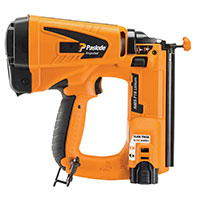
The straight nailer we are referring to is a second fix Paslode IM65, which is used to attach decorative trim and fixtures such as architrave and skirtings. Because this tool is not used for structural timber applications, such as studwork, joists, and roof trusses – the job of a first fix nailer – the second fix nails use a finer gauge wire. The thinner, 16-gauge brad nails provide a strong enough fix for the intended purpose, leaving a discreet, small hole, which can easily be filled and decorated.
It is classed as a straight nailer as the magazine that holds the nails is situated at 90–degrees to the drive assembly, which contains the driver blade that hits the end of the nail.
“70% of the 2nd fix nailers we sell are straight” Alan Harrison – Digital Sales Manager.
Advantages of IM65 Straight Nailer
- Takes a wider range of nails 19mm – 63mm.
- Slightly lower cost nails than angled versions.
Top tip – You will need to use an adaptor plate to fire 19mm and 25mm nails, which you will find in the box of your new machine. 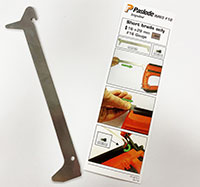
Disadvantages of IM65 Straight Nailer
- Struggles to get into tight corners and confined spaces.
The straight Paslode IM65 is compatible with the following nail and fuel packs
What is an angled nailer?
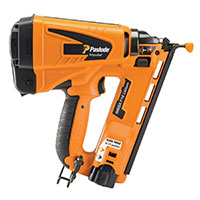
The IM65A angled nailer, is virtually identical to the straight machine, except the magazine is offset by 20 degrees. It takes the same 16-gauge wire nails, but they too are also set at a 20-degree angle.
Being able to tilt the front of the machine backwards prevents the front of the tool from hitting the workpiece, so it allows nails to be fired into tight corners or close to the floor. This would be impossible if you were using a straight nailer, and it is in these applications where an angled nailer is invaluable.
Advantages of IM65A Angled Nailer
- Allows access into tight corners and confined spaces.
- Slightly lighter in weight – by 100g.
Disadvantages of IM65A Angled Nailer
- Can only use nails between 32mm – 63mm.
- Slightly higher priced nails compared to straight.
The angled Paslode IM65A is compatible with the following nail and fuel packs.
Summary
If the nature of your work means you regularly find yourself having to fix into corners and tight spaces, then it is worth considering the angled 2nd fix nailer over the straight machine.
If this is a rare occurrence, or you simply think you can get by on these occasions, buy the straight nailer and save money on the nails.

Joint Managing Director, Protrade
Des has over 30 years of experience at Protrade, having worked in the capacity of Sales Co-ordinator, Account Manager, and product development, culminating in being appointed Joint Managing Director in 2018.



